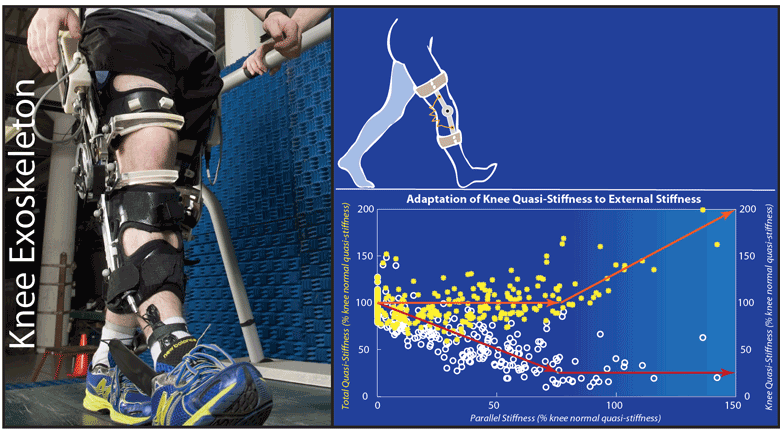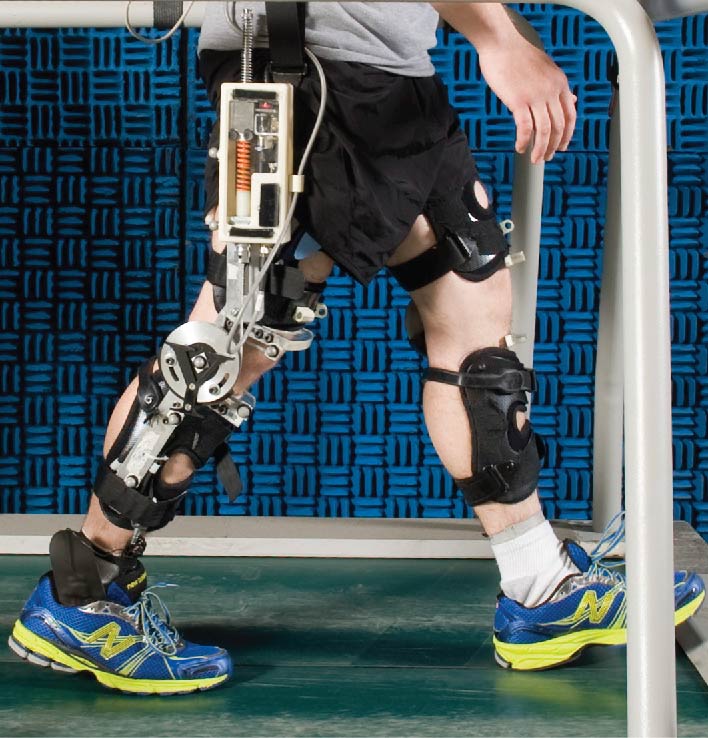 Lower-extremity exoskeletons have been actively investigated in the past few decades intending to augment the locomotion performance of able-bodied users in terms of metabolic cost, load carrying capacity, fatigue, and muscle force generation. While development efforts have been extensive, lower-limb exoskeleton devices have demonstrated limited success in achieving their augmentation goals, highlighting the need for more fundamental research on the interaction between human body and exoskeletons. In this paper, we investigated the effects of mechanical stiffness in parallel with the knee joint during walking. The human knee behaves similarly to a linear torsional spring during the stance phase of walking with a stiffness referred to as the knee quasi-stiffness. The spring-like behavior of the knee joint led us to hypothesize that we might partially replace the knee joint contribution during stance by utilizing an external spring acting in parallel with the knee joint. We investigated the validity of this hypothesis using a pair of experimental robotic knee exoskeletons that provided an external stiffness in parallel with the knee joints in the stance phase. We conducted a series of experiments involving walking with the exoskeletons with four levels of stiffness, including 0%, 33%, 66%, and 100% of the estimated human knee quasi-stiffness, and a pair of joint-less replicas. The results indicated that the ankle and hip joints tend to retain relatively invariant moment and angle patterns under the effects of the exoskeleton mass, articulation, and stiffness. A careful analysis of the knee moment profile indicated that the knee moment could fully adapt to the assistive moment; whereas, the knee quasi-stiffness fully adapts to values of the assistive stiffness only up to ~80%. Above this value we found biarticular consequences emerge at the hip joint.
Lower-extremity exoskeletons have been actively investigated in the past few decades intending to augment the locomotion performance of able-bodied users in terms of metabolic cost, load carrying capacity, fatigue, and muscle force generation. While development efforts have been extensive, lower-limb exoskeleton devices have demonstrated limited success in achieving their augmentation goals, highlighting the need for more fundamental research on the interaction between human body and exoskeletons. In this paper, we investigated the effects of mechanical stiffness in parallel with the knee joint during walking. The human knee behaves similarly to a linear torsional spring during the stance phase of walking with a stiffness referred to as the knee quasi-stiffness. The spring-like behavior of the knee joint led us to hypothesize that we might partially replace the knee joint contribution during stance by utilizing an external spring acting in parallel with the knee joint. We investigated the validity of this hypothesis using a pair of experimental robotic knee exoskeletons that provided an external stiffness in parallel with the knee joints in the stance phase. We conducted a series of experiments involving walking with the exoskeletons with four levels of stiffness, including 0%, 33%, 66%, and 100% of the estimated human knee quasi-stiffness, and a pair of joint-less replicas. The results indicated that the ankle and hip joints tend to retain relatively invariant moment and angle patterns under the effects of the exoskeleton mass, articulation, and stiffness. A careful analysis of the knee moment profile indicated that the knee moment could fully adapt to the assistive moment; whereas, the knee quasi-stiffness fully adapts to values of the assistive stiffness only up to ~80%. Above this value we found biarticular consequences emerge at the hip joint.

